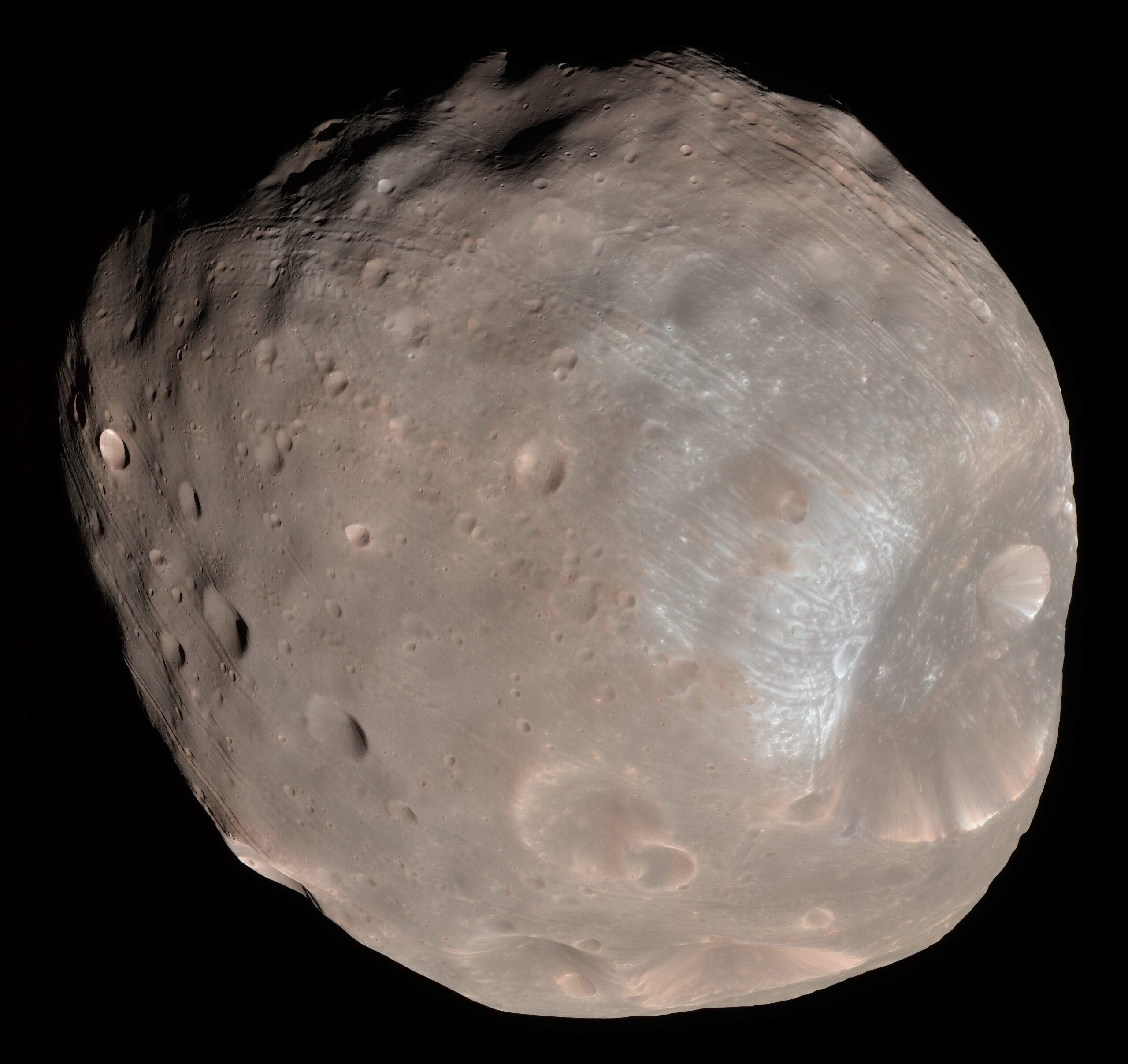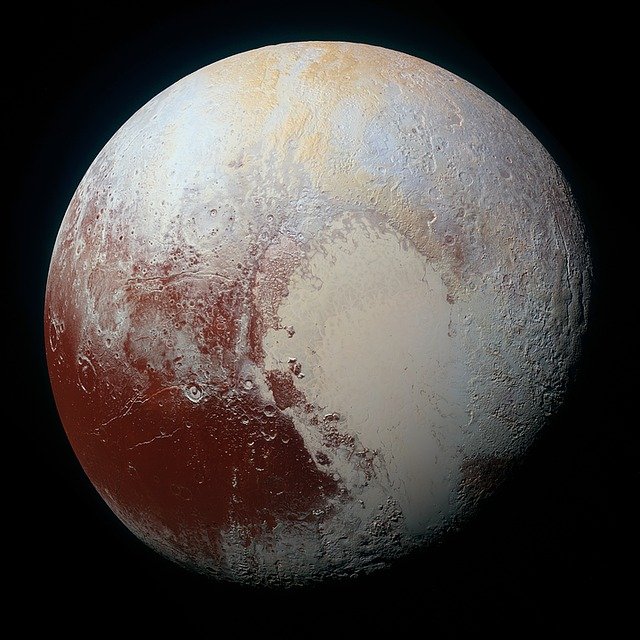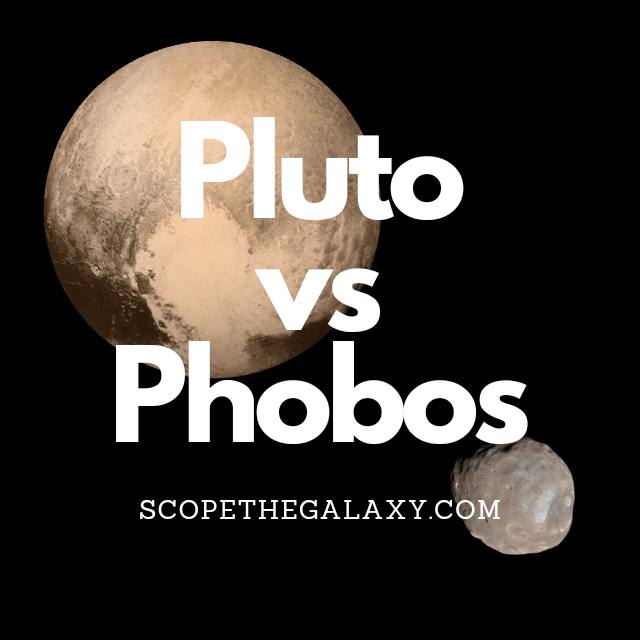*This post may contain affiliate links. This means we may make a commission if you purchase an item using one of our links*
The main differences between Pluto and Phobos are that Pluto is a dwarf planet while Phobos is a natural satellite, Pluto has 5 moons orbiting it while Phobos has 0, Phobos is far smaller with a diameter of 22.53km compared to Pluto’s 2,370km and Pluto is a spherical shape while Phobos is not.
There are a variety of other factors that differentiate these two from one another so, continue reading if you want a more detailed look at both bodies along with their similarities and differences below.
What Is The Moon Phobos?
Table of Contents

Phobos is the larger and innermost of the Martian moons, named after the Greek God of fear and panic. This rocky satellite measures approximately 27 x 22 x 18 kilometers and possesses an irregular shape.
Flying only 270 km above Mars’s surface, Phobos orbits the Martian surface so closely that it spins around the planet three times a day (each orbit takes 7 hours and 39 minutes). And this proximity means that the moon cannot always be seen from Mars’ surface (it all depends on where you’re standing).
In general, Phobos rises in the west, passes through the sky in around 4 hours, and sets in the east. And this process occurs twice during one Martian day.
Phobos travels 1.8 m closer to Mars every 100 years, which means this doomed moon will one day crash into its planet or break up into rings. Still, this won’t happen for another 50 million years or so.
The moon is covered in streak patterns from impact craters, the most significant of which is the crater Stickney, with a diameter of 9.7 km. Phobos has weathered thousands of meteorite impacts, one of which almost shattered it to pieces.
It was first discovered by the American astronomer Asaph Hall on 17th August 1877. But, it can be difficult for astronomers to see as it is one of the least reflective bodies in the solar system with an albedo of 0.071.
Despite its small stature, Phobos experiences wildly varying temperatures on its dark side compared to the light side. Measurements on the light side of the moon suggest that temperatures can rise to -4 degrees Celsius, a sort of brisk winter’s day that would be cold but tolerable.
In contrast, temperatures on the dark side can drop to -112 degrees Celsius, even though the two areas are just a few kilometers apart. The probable cause is fine surface dust that cannot retain heat, allowing temperatures to drop rapidly.
The low density of Phobos suggests its composition is similar to carbonaceous chondrite meteorites, which could mean that Phobos is a captured asteroid.
What Is The Planet Pluto?

In the past Pluto was the 9th farthest official planet in our solar system however, in 2006 after many debates between astronomers, the International Astronomical Union officially downgraded it to a dwarf planet.
The reason for this downgrade at the time was primarily down to Pluto simply being very small when compared to every other planet and even the moons orbiting these planets. Pluto’s dwarf status is debated still to this day but, for now it still remains under this dwarf bracket for a planet
Its diameter for example is only 2,370km, which is a third of Earth’s Moon. With that being said, despite the significant size discrepancy Pluto shows, it still does have more moon like objects orbiting it than Earth and I’m not saying just one more.
In total this terrestrial dwarf planet has 5.
Pluto’s atmosphere consists mostly of molecular nitrogen whilst molecules of methane and carbon monoxide have been observed also. As for its surface, it consist mostly of frozen nitrogen, methane, and carbon monoxide ices.
One of Pluto’s most unique characteristic is that Charon (its largest moon) is tidally locked to it and vice versa, which means that the two essentially orbit each other.
In essence only one side of Charon and one side of Pluto surface will face each other at any given time.
Pluto’s temperature is between -222 to -232 degrees Celsius based on how close it gets to the Sun when orbiting it, whilst its core temperature isn’t anything too special sitting around 500 – 1,000 degrees Celsius.
The main reason it’s as cold as it is and has a relatively cold core in comparison to the other planets would be, which is mostly down to its size. A larger size would mean more mass could be compressed at the center which would produce more heat at the core.
Pluto’s orbit is also different from the other main plants in our solar system, following an elliptical orbital path as opposed to the circular path the others take. As a result of its distance from the Sun, Pluto will complete each one of these elliptical cycles around once every 247.78 years.
Even its rotational cycle is very slow, where one cycle is completed in 157 hours. Another interesting fact is the Pluto’s axial tilt is almost on its side at 57 degrees, similar to Uranus.
Similarities Between Phobos And Pluto
Pluto and Phobos do share a few similarities, which includes the following:
- Both have a hotter central core.
- Both have a rocky, terrestrial surface.
- Neither have rings surrounding them.
- Both are tidally locked entities.
- Both orbit their respective celestial objects in an elliptical pattern.
- Neither have a magnetic field.
- Neither have tectonic plates
- Pluto’s density is 1.88 g/cm³ whilst Phobo’s density is 1.88 g/cm³.
Differences Between Phobos And Pluto
In regards to the differences between the two, they include the below:
- Phobos orbits Mars whilst Pluto orbits the Sun and its moon Charon.
- Pluto is a spherical shape while Phobos is not.
- Pluto has 5 moons while Phobos has no other objects orbiting it.
- Pluto is a terrestrial dwarf planet whilst Phobos is a terrestrial based natural satellite.
- Pluto has a diameter of 2,370km whilst Phobos has a diameter of 22.53km.
- Phobos has no atmosphere whilst Pluto’s atmosphere is composed mostly of nitrogen, methane, and carbon monoxide.
- A day on Phobos takes 7 hours 39 minutes and orbiting the Sun takes 687 days whilst a Pluto day 153 hours
- It takes Phobos 7 hours 39 minutes to orbit Mars while Pluto orbits the Sun in 247.78 years.
- Phobos’ temperature ranged between -4 to -112 degrees Celsius whilst Pluto has an average temperature of -222 to -232 degrees Celsius.
- Pluto’s mass is 1.309 x 10^22 kg whilst Phobos’ mass is 10.6 × 10^15 kg.
- Phobos’ gravitational strength is 0.0057 m/s² whilst Pluto’s is 0.62 m/s².
- Phobos only orbits Mars 6,000km away and is getting closer to the planet by 1.8 meters every 100 years while Pluto orbits the Sun roughly 5.9 billion kilometers away.
- Pluto has a hotter central core while Phobos does not.
- Pluto has an axial tilt of 57 degrees whilst Phobos’ is practically 0.
Summary
Pluto and Phobos do have a few similar features such as the fact both orbit their planets in a drastic elliptical orbit and are tidally locked to another entity but, they’re very different from each other too.
Whether it be in regards to size, mass, their physical shape, axial tilt and even their composition so, in the grand scheme of it all, Pluto and Phobos are very much their own easily recognisable distinct entities.

